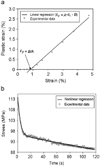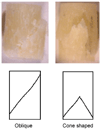Progressive post-yield behavior of human cortical bone in compression for middle-aged and elderly groups
- PMID: 19150716
- PMCID: PMC2909502
- DOI: 10.1016/j.jbiomech.2008.11.016
Progressive post-yield behavior of human cortical bone in compression for middle-aged and elderly groups
Abstract
In this study, a progressive loading regimen (load-dwell-unloading-dwell-reloading) was applied on bone samples to examine the compressive post-yield response of bone at increasing strain levels. Cortical bone specimens from human tibiae of two age groups (middle-aged group: 53+/-2 years, 4 females and 4 males, elderly group: 83+/-6 years, 4 females and 4 males) were loaded in compression using the progressive loading scheme. Modulus degradation, plastic deformation, viscous response, and energy dissipation of bone during post-yield deformation were assessed. Although initial modulus was not significantly different between the two age groups, the degradation of modulus with the applied strain in the elderly group was faster than in the middle-aged group. The modulus loss (or microdamage accumulation) of bone occurred prior to plastic deformation. Plastic strain had a similar linear relationship with the applied strain for both middle-aged and the elderly group although middle-aged bone yielded at a greater strain. The viscoelastic time constant changed similarly with increasing strain for the two groups, whereas a higher magnitude of stress relaxation was observed in the middle-aged group. Energy dissipation was investigated through three pathways: elastic release strain energy, hysteresis energy, and plastic strain energy. The middle-aged group had significantly greater capacity of energy dissipation than the elderly group in all three pathways. The information obtained may provide important insights in age-related effects on bone fragility.
Conflict of interest statement
Each author in this manuscript does not have and will not receive benefits in any form from a commercial party related directly or indirectly to the content in this manuscript. The authors declare that they have no competing financial interests.
Figures














Similar articles
-
Orientation dependence of progressive post-yield behavior of human cortical bone in compression.J Biomech. 2012 Nov 15;45(16):2829-34. doi: 10.1016/j.jbiomech.2012.08.034. Epub 2012 Sep 17. J Biomech. 2012. PMID: 22995144 Free PMC article.
-
Differences in the mechanical behavior of cortical bone between compression and tension when subjected to progressive loading.J Mech Behav Biomed Mater. 2009 Dec;2(6):613-9. doi: 10.1016/j.jmbbm.2008.11.008. Epub 2008 Dec 13. J Mech Behav Biomed Mater. 2009. PMID: 19716106 Free PMC article.
-
Mechanical behavior of human cortical bone in cycles of advancing tensile strain for two age groups.J Biomed Mater Res A. 2009 May;89(2):521-9. doi: 10.1002/jbm.a.31974. J Biomed Mater Res A. 2009. PMID: 18437693 Free PMC article.
-
Age-related factors affecting the postyield energy dissipation of human cortical bone.J Orthop Res. 2007 May;25(5):646-55. doi: 10.1002/jor.20337. J Orthop Res. 2007. PMID: 17266142 Free PMC article.
-
Differences between the tensile and compressive strengths of bovine tibial trabecular bone depend on modulus.J Biomech. 1994 Sep;27(9):1137-46. doi: 10.1016/0021-9290(94)90054-x. J Biomech. 1994. PMID: 7929463 Review.
Cited by
-
Post-yield and failure properties of cortical bone.Bonekey Rep. 2016 Aug 24;5:829. doi: 10.1038/bonekey.2016.60. eCollection 2016. Bonekey Rep. 2016. PMID: 27579166 Free PMC article. Review.
-
Post-yield nanomechanics of human cortical bone in compression using synchrotron X-ray scattering techniques.J Biomech. 2011 Feb 24;44(4):676-82. doi: 10.1016/j.jbiomech.2010.11.003. Epub 2010 Nov 26. J Biomech. 2011. PMID: 21112589 Free PMC article.
-
Constitutive relationship of tissue behavior with damage accumulation of human cortical bone.J Biomech. 2010 Aug 26;43(12):2356-61. doi: 10.1016/j.jbiomech.2010.04.026. Epub 2010 May 15. J Biomech. 2010. PMID: 20472239 Free PMC article.
-
Orientation dependence of progressive post-yield behavior of human cortical bone in compression.J Biomech. 2012 Nov 15;45(16):2829-34. doi: 10.1016/j.jbiomech.2012.08.034. Epub 2012 Sep 17. J Biomech. 2012. PMID: 22995144 Free PMC article.
-
Damage in total knee replacements from mechanical overload.J Biomech. 2016 Jul 5;49(10):2068-2075. doi: 10.1016/j.jbiomech.2016.05.014. Epub 2016 May 20. J Biomech. 2016. PMID: 27237382 Free PMC article.
References
-
- Akkus O, Rimnac CM. Cortical bone tissue resists fatigue fracture by deceleration and arrest of microcrack growth. Journal of Biomechanics. 2001;34:757–764. - PubMed
-
- Bouxsein ML. Bone quality: where do we go from here? Osteoporosis International. 2003;14:S118–S127. - PubMed
-
- Bredbenner TL, Davy DT. The effect of damage on the viscoelastic behavior of human vertebral trabecular bone. Journal of Biomechanical Engineering. 2006;128:473–480. - PubMed
-
- Burr DB, Hooser M. Alterations to the en bloc basic fuchsin staining protocol for the demonstration of microdamage produced in vivo. Bone. 1995;17:431–433. - PubMed
-
- Burr DB, Forwood MR, Fyhrie DP, Martin RB, Schaffler MB, Turner CH. Bone microdamage and skeletal fragility in osteoporotic and stress fractures. Journal of Bone and Mineral Research. 1997;12:6–15. - PubMed
Publication types
MeSH terms
Grants and funding
LinkOut - more resources
Full Text Sources

